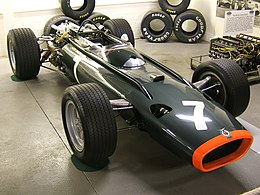BRM P83
 |
|||||||||
| Category | Formula One | ||||||||
|---|---|---|---|---|---|---|---|---|---|
| Constructor | British Racing Motors | ||||||||
| Designer(s) |
Tony Rudd John Crosthwaite |
||||||||
| Predecessor | BRM P261 / BRM P67 | ||||||||
| Successor | BRM P115 | ||||||||
| Technical specifications | |||||||||
| Chassis | Duralumin monocoque | ||||||||
| Suspension (front) | Double wishbone, with inboard spring/damper units | ||||||||
| Suspension (rear) | Double wishbone, with outboard coilover spring/damper units | ||||||||
| Axle track | F: 59 in (1,499 mm) (adj.) R: 60 in (1,524 mm) (adj.) |
||||||||
| Wheelbase | 96 in (2,438 mm) (adjustable) | ||||||||
| Engine | BRM P75 2,999 cc (183.0 cu in) H16 naturally aspirated, mid-mounted | ||||||||
| Transmission | 6-speed manual | ||||||||
| Weight | 1,480 lb (671.3 kg) | ||||||||
| Fuel | Shell | ||||||||
| Tyres | Dunlop, Goodyear | ||||||||
| Competition history | |||||||||
| Notable entrants |
Owen Racing Organisation Reg Parnell Racing |
||||||||
| Notable drivers |
|
||||||||
| Debut | 1966 Italian Grand Prix | ||||||||
|
|||||||||
| Constructors' Championships | 0 | ||||||||
| Drivers' Championships | 0 | ||||||||
| n.b. Unless otherwise stated, all data refer to Formula One World Championship Grands Prix only. |
|||||||||
The BRM P83 was a Formula One racing car designed by Tony Rudd and built by British Racing Motors for the new engine regulations of 1966. It used a highly unorthodox H16 engine which caused problems throughout the car's racing life, and despite the best efforts of Graham Hill and Jackie Stewart took BRM from championship contenders to also-rans, leading it to be regarded alongside the BRM Type 15 as another embarrassing failure for the British marque caused by a fetish for overcomplicated engineering.
After winning the 1962 Drivers' and Constructors' championships BRM had finished second each year, coming close to the championship in 1964 and having a promising 1965 season with the excellent P261. In 1966 the Formula One regulations with regards to engines were changed from a maximum 1.5 litres normally aspirated to either 3 litres normally aspirated or 1.5 litres supercharged following complaints that the smaller engines used from 1961 to 1965 weren't powerful enough for the premier category of motorsport. As a result, many teams were left looking for a new engine supply while BRM, who built their own very successful V8 engines, had to decide on what manner of new engine to develop to meet the new formula.
BRM decided to hedge their bets by developing their existing 16 valve 1.5 litre V8 into a 32 valve 3 litre H16 (effectively two flat 8s one on top of the other and geared together) while also developing a new 48 valve 3 litre V12 in partnership with Harry Weslake and opt for whichever turned out to be the better powerplant. After much debate Sir Alfred Owen decided BRM would go with the H16 and Weslake bought out BRM's involvement in the V12 and produced the engine that went on to power the Eagle T1G. The H16's development was complicated by BRM's involvement in two further V12 designs and a 4.2 litre version of the H16 for Lotus to use at Indianapolis.
Various crankshaft vibration problems dogged the engine from the start, and to compound matters quick-fix balancing weights attached to the crankshafts developed the unfortunate habit of detaching themselves and flying off within the engines causing several catastrophic engine failures. Each side of the engine had to have its own water radiator, fuel metering unit, distributor and water pump, with a common oil radiator. The sheer complexity of the engine led to a truly terrible record of unreliability; engine, transmission and related problems caused 27 of the powerplant's 30 retirements from 40 entries. Jackie Stewart said of the engine "it was unnecessarily large, used more fuel, carried more oil and needed more water - all of which added weight and diminished the vehicle's agility"
...
Wikipedia
